Testimonies
Here is a selection of testimonies submitted to us via e-mail or Facebook, and originally published on our Hungarian-language website. These testimonies were selected and, unless stated otherwise, translated into English by Gwen Jones. To submit a story, please write to bertalan@ceu.edu.
2014. May 19., Monday

Here is a description of Perczel Mór Street 4, where I live. The original owner, Mrs. Vilmos Grauer, lived in our apartment and next door’s too. Her husband was a vinegar producer, and her father, Mr. Herzmann, built the whole house. During the war, there were apparently five Jewish families living in our apartment.
The earlier owner told me the following, and I’ve just asked him for the details. He sent me the following documents:
Perczel Mór Street 4.
… Mrs. József Varga moved into the house as concierge from April 1, 1944. About the history of the house, she said:
The building was built by Bertalan Herzmann for Mrs. Vilmos Grauer. The widow Grauer lived on the third floor, and they had a vinegar factory at Rákóczi Road 49.
On the first floor lived General Géza Lakatos, the Prime Minister, with his wife, sister and Elemér Ragályi, his brother-in-law. The Arrow Cross placed the yellow star on the house while the Lakatos family still lived there.
The second floor was inhabited by Mrs. Zsigmond Erdély with her son Aurél and his family. They were the owners of the “Agrár Industria” Company. The Company’s office was also in their apartment. The Soldiers’ Resistance Movement had one of their meeting places in the Erdély family’s apartment. Vilmos Tartsay and János Kiss were seen there many times.
The widow Mrs. Vilmos Grauer received a protection document from the Arrow Cross [Hungarian State Security Surveillance chief] Péter Hain, and the house became a yellow-star house. Mrs. Grauer looked after abandoned and orphaned Jewish children in her apartment. She used typhus infection certificates from the local district medical officer, Dr. Dobi, to stop the Arrow Cross from harassing her so much. The Swedish embassy secretary Raoul Wallenberg brought food for the children in the house.
On Christmas night 1944, the Arrow Cross wanted to drive the children out, but Mrs. Varga begged her way out of the house, and ran to the German command on Október 6 Street. From there she begged an SS major called Kurt to go back with her to the house, and he chased the Arrow Cross out of the building. This is how the children could escape.
Many bombs fell on the house, but none exploded, so there was no significant damage.
I learned from the story that although the widow Mrs. Grauer and her son had a protection letter, the Arrow Cross still executed them.
On January 18, 1945, the Russians occupied the house and for the residents, this meant the storm of war had passed.
The owners of the property:
1900: Hungarian Royal Treasury
1912: Bertalan Herzmann and his wife
1928: Dr. Vilmos Grauer
1937: Mrs. Vilmos Grauer
Tibor Végh
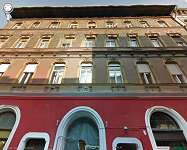
My father Imre Nádor (Neuman) lived in the house at Dob Street 52. It's from here that he was taken away for so long. On September 1, 1940, he was taken on forced labor service from here via Vác to Transylvania, from where he was demobilized on March 31, 1941. Freedom didn't last long: on May 1, 1942, he was taken again via Vác to Ukraine, and from there on March 27, 1944, via Hungary to Mauthausen, where he was liberated on May 5, 1945. He arrived in Budapest on August 31, 1945. As one can see, this took four and a half years from his life. I knew this until now, but as I write it down, I shudder.
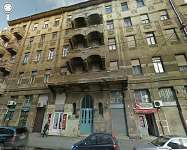
In the days following October 15, 1944, we fled with my mother from Népszínház Street 22, where I was born. The next day, the Arrow Cross took all the women away from the house, and none of them came back. We found out that they ended up in Bergen Belsen.
Those terrible days, the fear and terror have stayed with me until today. On October 15, Arrow Cross soldiers entered the house looking for Jews, and one of our neighbors (whose name I still have not forgotten) directed them to the apartments where Jews were living.
2014. May 15., Thursday
Gömb Street 36 – Szegedi Road 9 – Üteg Street 18.
This large, U-shaped house in Angyalföld had entrances on three streets, and was designated as a “yellow-star house.” It was in fact a mixed house, lots of the old residents stayed on living there. There were no problems between them, as children we played together. Its advantages was that it had many front gates, and so it was often possible to trick the Arrow Cross, who would have gathered us all up. I’d be glad if anyone else who was there got in touch.
2014. May 13., Tuesday
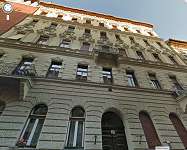
I and my mother stayed at VI. Eötvös Street 27, sharing a one-roomed apartment with an aunt and great-aunt. I remember rather painfully that my father came to visit us from his forced labour unit for a couple of days (a great privilege, gained with heavy bribes), but the concierge got very worried about his unregistered presence in the house, and reported him to the Arrow Cross. He was dragged away and we never saw him again. My mother then found out that in a few days the occupants of the building were going to be transferred to the ghetto, and she managed to get us out into a 'protected house' of the Swedish Embassy - but that's another story.
2014. May 12., Monday
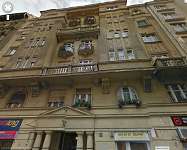
We were liberated in Katona József Street 10/a. This was a Swedish protected house, and all three of us--my father, mother and me--owned Swedish protection passports. I was a child at the time, but I remember that we were afraid of the concierge. My father left the house without his yellow star on, to find bread. Before the Russians arrived, a horse died in front of the gate. I remember that there were soldiers on the fourth floor looking in the direction of the Víg Theater to see what had happened. I know that everyone was taken from the house on the corner of Csáky Street and the other side of Katona József Street, and shot into the Danube, because the concierge had denounced the house at the nearby Arrow Cross house on Szent István Boulevard 6. I think that was a Swedish protected house too. The concierge was later captured, but that didn't help the people who had been killed.
Before my father acquired the Swedish protection passport, we were living in the Jewish house with my mother, just the two of us, because my father had been taken away (that's a long story). One day, some gendarmes and Arrow Cross men came into the house and everyone had to assemble in the courtyard. They ordered us outside to be taken to dig ramparts. All the apartments were mostly full of women and children, all sharing an apartment. They took us out to the Horseracing Track, where we spent the whole day waiting. Women with Christian husbands were standing in a separate line, and they had telegrams to prove that their husbands had died a hero's death. I only wanted to stay with my mother's friend who was standing in this line. We snuck over and the women hid us somehow. Every group left for somewhere, and only that group was allowed to return home late at night. We didn't have any sort of papers on us, but a guard at the gate must have felt sorry for us and let both of us out. It was only after the war that we learned that everyone else had been taken to Auschwitz or other camps, and only one person returned from there. The children I had played with on the corridor of the house never came back.
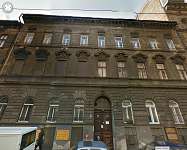
One episode from the many hardships endured during early fall 1944, in the yellow-star house at Izabella Street 52, sixth district:
I moved into this residential house in 1938, at the age of 11, with my parents and older sister. The house had an internal walkway and no elevator, and the people who lived there were generally lower middle-class or poor. Given my age at the time, I only partly perceived the approaching danger and tragedies. By the time March 19, 1944 came around, I had grown up, although I wouldn’t say this period was a carefree teenage era, but rather a youth that was stolen, made impossible, and which preceded and followed those days. For this reason, I still feel that loss to this day.
Since we lived at Izabella Street 52, close to Andrássy Avenue, on that day [March 19], with lumps in our throats and full of fear, we saw with our own eyes the German tanks and military vehicles proceeding up towards Heroes’ Square. Accompanied by German marching tunes, legions of soldiers marched in disciplined columns, their boots clacking. It was hair-raising. I was at home; there was no school.
The situation grew worse from day to day. If I remember well, they ordered the establishment of yellow-star houses in April [NB: it was June]. This meant that the yellow star appeared on 10-20 houses, and whoever didn’t live in one of these houses had to leave their home within 2-3 days, and somehow find a place in a designated yellow-star house. Of course, the Christians living in yellow-star houses had to leave their apartments in a hurry so that they could choose from among the far better Jewish apartments, and they could take all their things with them.
If we can call it luck, Izabella Street 52 became a yellow-star house. We had to take in three more families into our apartment, plus an 80-year-old grandmother, who arrived with her belongings. One can imagine how we had to live, with so many people sharing a small bathroom and one kitchen. We hardly had anything to eat, and because of the curfew, we could only go out for a few hours a day, when people descended on the almost empty shops.
At that point, the concierge system was still functioning. From the service apartment, they oversaw order in the house, cleaned, and so on. Well, we landed an absolutely malicious, cruel concierge couple, who were more antisemitic than the average. They were the only Aryan family in the house, and they made it their duty to oversee strict compliance with the sanctions against Jews, and they ordered us to inform on one another. Out of fear, they went over and above what was necessary. Since the concierge was also the house supervisor, if something had to be conveyed to the house, they sounded the “bell” using a pestle and mortar, at which everyone rushed out of their apartments. One late October or early November noon, we heard this signal again. When we went out to listen, we saw that a squad of Arrow Cross commandos had invaded the courtyard, who ordered everyone to immediately come down into the courtyard in their coats, and without any luggage. Like sheep, we took with us the 6-7-week-old baby and one-year-old child downstairs with us, obeying the order without opposition, just like the rest of the residents. Once the people of the house were gathered together, the Arrow Cross informed us that they were taking us away. They didn’t say where to, but the front gate was locked so that nobody could escape. As we stood waiting to depart, having left our apartment front doors open, that’s when we heard the famous statement: “CAN I LET ‘EM OUT?” from the concierge who, gloating, then opened the front gate and led the residents out onto the street. There must have been 150-200 of us. We briefly saw other similar groups, with whom we were joined up to make a long marching column. Armed Arrow Cross striplings escorted us on both sides, holding us in their rifle sights, and issued the word of command: Long live Szálasi! This is how we were force-marched for a long time, hands in the air, until we learned that our destination was the Tattersaal (later Ügetőpálya) racing track, behind Keleti Station in Pest. We reached there at dusk. It was a huge, empty space, capable of holding thousands of people, close to the Keleti and Józsefváros railway stations, from where they would have deported us in wagons the next day. Who knows where?
Evening and night came, everyone sat about on the ground underneath the heavens, all crammed in together, hungry and thirsty, and shivering, without any provisions. Alongside the crying, wailing, and fear, my most terrible memory of that night is that a relative had an epileptic fit. I won’t go into details, but I had never seen anything like it. I understood then why they hadn’t taken him into forced labor service. By morning we were broken and freezing, when the news spread that they were letting us go: everyone could go home. It was almost unbelievable, and yet this is how it happened. Afterwards, we learned that the many thousands of Jews gathered together, probably to be forced onto wagons, had been saved by Wallenberg’s intercession. Wearily, we returned once again to the Izabella Street yellow-star house.
After (and before) this incident, we went through many dramatic events and the fear of death. My 21-year-old sister stepped out of the house on Izabella, Arrow Cross henchmen snatched her away, and we never saw her again.
The long-awaited Liberation brought huge relief, but I cannot free myself of the emotional damage, in fact the older I am, the more the whole nightmare hurts.
Today, in the so-called “free Hungary” over the past few years, those ludicrous theories have been returning with more and more force, and there is always something happening that opens up old painful wounds. On my part, my frequent fears and nightmares about the future are because of the smoke-screening of the past. Only an honest education system that reflects reality could sort out the present and the future in the minds of generations. I am anxious for my family on the grounds of just one fragment of what I have lived through in the past.
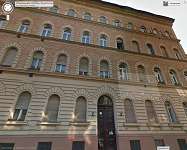
From 1934 to my mother’s death in 2004, our family lived for 70 years at Barcsay Street 11. In 1934, and as a result of the global economic crisis, my great-grandfather Lipót Nemes, a furniture trader, and my grandfather József Fischer, a corn trader, both became poor. My great-grandparents and grandparents decided they couldn’t maintain two apartments any longer, and moved in together.
This is when they rented the third-floor apartment at Barcsay Street 11. My mother was 18 years old at the time, and preparing for her high-school matriculation exams. Her older brother was studying to become an electrical engineer at the German-language university in Prague: because he was of Jewish origin, he could not enroll in a Hungarian university. His sister was nine years old.
After the high school matriculation, my mother studied to become a seamstress, and then worked with her aunt. In the meantime, her brother finished university but there was no chance for him to work as an engineer (because of the anti-Jewish laws). In order not to forgot what he had learned, he went to work for free as an electrician.
In 1939 my mother married a Hungarian Jew who had fled from Poland, they moved to Szövetség Street. In 1941, my great-grandfather died.
Poland had already been occupied by the Germans, and Polish Jews living abroad were caught, put on wagons, made to dig their own graves and then shot. This is what awaited my mother’s husband too.
This is how my mother described what happened:
“One afternoon a woman shouted our names from the street, and told us to flee because my husband’s brother had just been taken away 10 minutes earlier, and now they were coming for us. In meager clothing and slippers, we ran like mad to my mother’s place on Barcsay Street, and learned from the concierge there that they really were looking for us. The concierge said that he hadn’t seen us for a long time, and was sure that we’d been taken away. He was a good man. When the madness died down about a week later, we went back to our apartment. But from that moment on, my life was nothing but fear, and in particular after I learned that my husband’s two sisters and father had already been taken away. My husband was called up again for forced labor service in 1943.”
“On March 19, 1944, the Germans entered the country. This was announced on the radio every 10 minutes. Terrible days followed. Jews had to wear the yellow star. Jewish houses were established, and the Barcsay Street house was one of them. All different kinds of news spread, for example that the cellars of these houses would be filled with gas, and all sorts of things like that. We were advised to go and work in a factory which was part of the war effort, because there you would be protected from the Arrow Cross. My younger sister was already in work using false papers, and it’s through her that I came to the Gyömrői Road brick factory.”
This is where my mother met my father, in the brick factory; he had escaped from forced labor and was working there too. They helped each other hide and both survived the war. My mother’s first husband never returned from forced labor.
My grandparents had to leave the yellow-star house for the ghetto, from where my aunt smuggled them out with false papers and got them into hiding. My great-grandmother was shot in the head by the Arrow Cross when she went out to visit her husband’s grave at the Jewish cemetery.
My grandfather died in 1948 when I was two years old; my grandmother died in 1963. She was the only one of my grandparents I could ever know and love.
I was born in 1947 in Jászberény, where my father had a place. After the war, my parents married and moved to Jászberény. My younger sister was born soon afterward. In 1949 we moved up to Pest, to Barcsay Street 11. I lived here until 1969, when I got married.
2014. May 08., Thursday
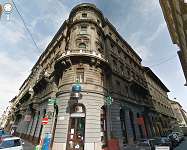
The house on Teréz Boulevard was not a yellow-star house, which is why we had to leave our apartment. The house we moved to on Jókai Street belonged to the Foncière insurers, whose office was on the second floor, even when it became in a yellow-star house from June 1944. From the end of October 1944 [after the Arrow Cross took power], it was a refuge for Swedish diplomatic employees, and under diplomatic protection, run by Raoul Wallenberg. The apartment on Jókai Street was a smaller, three-room apartment. This was a forced exchange.
My mother, father, brother, aunt and uncle Károly also lived there. When Wallenberg was working, there were already too many of us, with at least 20-25 people in the apartment. We were squeezed into one room. Some Christian residents who hadn’t left were still living in the house, including the concierge. At the break of day on January 8, 1945, and on the basis of the concierge’s “charitable deed,” an armed Arrow Cross company appeared. He might had told them that there were Jews here, unlawfully, in case there was anything left they could steal. I don’t know. What’s important is that a couple of Arrow Cross men appeared that night. I was 11 years old at the time. The whole company—whoever could still move, because whoever could not was shot in the head, this is how it was—was taken to the Arrow Cross house at Városház Street 14. This also came to the attention of Wallenberg, who appeared in the Arrow Cross house, and so the next day we were taken to the Pest ghetto, to the house at Akácfa Street 54. Over the next few days, my father and uncle were taken to the banks of the Danube, where they were shot into the river. Naturally, their corpses were never recovered. Liberation took place on January 18, 1945.
From the Centropa archive.
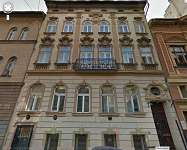
My mother behaved the best, as we’d say today, according to how one needed to behave in 1944. And not like how the Jewish Council said. Because the Jewish Council was always saying that we had to observe all the regulations, and then there wouldn’t be any trouble. You had to be well-behaved. My mother said: no. We are an army- and Christian family, we have Christian papers, we are not even Jewish. We shouldn’t wear the yellow star. But Wesselényi Street 75 became a Jewish [yellow-star] house, and that’s where my grandmother, László Fóti, his wife and two children, stayed.
The oldest child, who was one year younger than me, was 18 and he was called up. There was a poster which said that everyone aged from 18 to 60 had to go. They were taken to Jászberény and Bor [to the Bor copper mines where Jehovah’s Witnesses and Jews were placed into forced labor battalions]. The other son was younger and stayed behind. The family was terribly unhappy, particularly my grandmother. The older son Tomi was brought up by my grandmother, all the family members worked in the Koh-i-noor shoe paste factory, we didn’t have time. When we still had to be afraid of deportation, before the Lakatos government came into power, my grandmother, László Fóti, Auntie Bözsi and the youngest child moved in with us on Aréna Road 15, because my mother said it was a safe place to be. At that point my grandmother didn’t have any problems. This was where she learned that her favorite grandchild had been deported [to a German concentration camp, either Flossenburg, Saschsenhausen, Oranienburg or Buchenwald], and that’s when she completely collapsed and fell ill. At the end, a doctor came out to us and said she had cancer. It’s possible, since she’d already had cervical cancer, but maybe it was brought on by the events.
After my wedding, I moved into my father-in-law Jenő Pór’s apartment. He lived in the house he owned at Vörösmarty Street 13. When this became a yellow-star house, and was full of Jews, we moved with my father-in-law to my mother’s apartment at Aréna Road 15, and hid at a lieutenant’s place. We were there with my mother for two weeks. During this time, the Jews were taken away from Vörösmarty Street and the yellow-star house remained empty. That’s when we moved back into Vörösmarty Street 13. During the siege, we took up the entire ground floor, we were the lords of the house, and there was not even one Jew left, only Christians who had moved in. The rest of the Jews had been taken to the ghetto, or shot into the Danube, or to the KISOK playing fields, wherever. The old Jewish residents gave their furniture to the Christians whose homes had been bombed. We were liberated in Vörösmarty Street. I owe many thanks to my father-in-law. He had a letter from Bishop Ravasz saying that he was the deacon of the Good Shepherd Committee. The Arrow Cross accepted this paper, signed by Bishop Ravasz. The paper said that he, his child and wife, enjoyed protection.
From the Centropa archive.